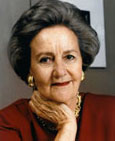Our Company
History
Remembering Katharine Graham (1917-2001)

Memories:
Special Report from washingtonpost.com:
 Katharine Graham Remembered
Katharine Graham Remembered
Articles by and about Mrs. Graham, book excerpts and photos.
Kay Graham's Management Career
By Warren E. Buffett
Katharine Graham told her story far better than I can: Personal History is simply the best autobiography I’ve ever read. What I can add, however, is some perspective on her managerial career gained from a ringside view, which I was lucky enough to have for many years. Kay’s business odyssey was unique. She became responsible for the company’s operations in 1963, painfully unsure of herself, but totally sure of her principles.
She had been taught all her life — wrongly — that only men possessed a managerial gene. But she also understood completely — and correctly — that independent and first-class journalistic institutions are key to creating and preserving a great society. When the obligation to manage such an institution was thrust upon her by her husband’s death, she felt she had no choice but to march forward — however loudly her knees might be knocking.
And how she marched! The Pentagon Papers and Watergate are milestones in journalistic history that will be recalled and studied for centuries. But these heralded journalistic successes were matched as well by quiet business success. On June 15, 1971, The Washington Post Company went public at $6.50 per share (adjusted for a subsequent 4-for-1 split). When Kay stepped down as CEO on May 9, 1991, the price was $222, a gain of 3,315 percent. During the same period the Dow advanced from 907 to 2,971, an increase of 227 percent.
This spectacular performance — which far outstripped those of her testosterone-laden peers — always left Kay amazed, almost disbelieving. She was never quite sure where debits and credits belonged and couldn’t shake the feeling that the lack of an MBA degree destined her for business failure.
Of course, none of that mattered at all. For Kay understood the two most basic rules of business: First, surround yourself with talented people and then nourish them with responsibilities and your gratitude; second, consistently deliver a superior, ever-improving product to your customer. Among journalistic leaders, no one carried out either task better than she. The consequence was outsized profits. Indeed, if we look at newspaper and television profit margins on what I would term a “quality-adjusted” basis, she took The Washington Post Company from near the bottom straight to the top.
The managerial problem that caused Kay the most anguish was the pressmen’s strike in 1975. During the preceding years, conditions in The Post’s pressroom had deteriorated to a state approaching anarchy. Finally, on October 1, the union walked out, after first disabling all presses, setting fire to one, and severely beating a foreman. The union’s members, smug in the knowledge that a long strike could kill the paper, were certain that Kay would fold. Instead, she took them on.
In the strike’s early days, the competing Washington Star bulged with ads while an emaciated Post lost readers and advertisers at an alarming rate. During that period I watched Kay suffer, tormented by the thought that she was destroying what her family had spent more than 40 years building. Some of her most trusted advisors urged her to cave. But, with her knees knocking louder than ever before, she persevered — and won.
Kay brought brains, character, guts, and, not to be omitted, the deepest sort of patriotism to her job as CEO of The Washington Post Company. She always said that what she most wished for was a Pulitzer in management. In my book, she earned one.


